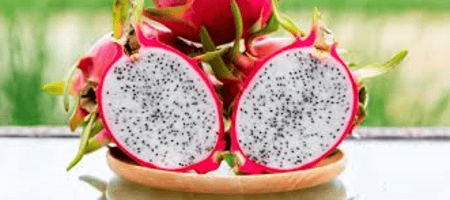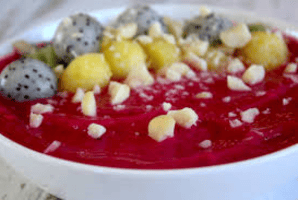Have you ever wandered through the exotic fruit section of your local market and been captivated by a peculiar pink or yellow fruit with scale-like skin resembling a mythical creature? That’s dragon fruit—a true nutritional treasure that’s been gaining popularity worldwide.
The benefits of dragon fruit extend far beyond its Instagram-worthy appearance, offering an impressive array of vitamins, minerals, and antioxidants that can significantly enhance your wellbeing.
This article will explore the numerous health benefits of dragon fruit, delve into its nutritional profile, and share delicious recipes that will help you incorporate this exotic superfood into your daily routine.

What Exactly Is Dragon Fruit?
Dragon fruit comes from several cactus species belonging to the genus Hylocereus. Its distinctive appearance features a leathery, bright-colored exterior (typically hot pink or yellow) with green scales reminiscent of a dragon, hence its name.
When dragon fruit is split open, the white or magenta flesh is dotted with tiny edible black seeds that have a feel similar to kiwi seeds. It has a refreshing watermelon-like texture and a subtle sweetness that is frequently compared to a hybrid between a kiwi and a pear.
Dragon fruit comes in three primary varieties:
White-fleshed dragon fruit (Hylocereus undatus) – The most common variety with pink skin and white flesh
Red-fleshed dragon fruit (Hylocereus polyrhizus) – Bright magenta flesh with pink skin

Yellow dragon fruit (Hylocereus megalanthus) – Yellow skin with white flesh, typically sweeter than the other varieties
Nutritional Profile of Dragon Fruit
One of the key benefits of dragon fruit is its impressive nutritional density without excessive calories. A serving of dragon fruit weighing 100 grams includes roughly:
- Calories: 60
- Protein: 1.2 grams
- Carbohydrates: 13 grams
- Fiber: 3 grams
- Vitamin C: 3% of the Daily Value (DV)
- Iron: 4% of the DV
- Magnesium: 10% of the DV
- Vitamin E: 4% of the DV
Additionally, dragon fruit contains smaller amounts of calcium, phosphorus, and B vitamins, making it a well-rounded addition to a balanced diet.
Top Health Benefits of Dragon Fruit
Powerful Antioxidant Properties
Perhaps one of the most significant benefits of dragon fruit is its remarkable antioxidant content. The fruit contains betalains, hydroxycinnamates, and flavonoids—antioxidant compounds that help protect your cells against damage from free radicals.
The red-fleshed varieties are particularly rich in betalains, which give them their vibrant color and have been linked to anti-inflammatory effects. Regular consumption of dragon fruit can help strengthen your body’s defense system against these harmful processes.
Supports Digestive Health
Dragon fruit’s remarkable fiber content allows its advantages to extend to digestive health. With about 3 grams of fiber per 100-gram serving, dragon fruit promotes healthy digestion by preventing constipation and maintaining bowel regularity.
Additionally, dragon fruit contains prebiotics—specifically, oligosaccharides—that serve as food for your gut’s beneficial bacteria
Boosts Immune Function
Looking to strengthen your body’s natural defenses? The immune system is supported by dragon fruit because of its vitamin C concentration and other antioxidants. Vitamin C plays a vital role in immune cell function and helps protect against common illnesses.
Moreover, dragon fruit contains vitamin B complex vitamins that contribute to overall immune health by supporting cellular function and energy metabolism.
Heart-Healthy Benefits
Heart disease remains a leading cause of death worldwide, making the cardiovascular benefits of dragon fruit particularly valuable. The fruit contains several compounds that support heart health:
Fiber: Helps reduce bad cholesterol levels (LDL)
Antioxidants: Fight oxidative stress and inflammation, two factors that lead to heart disease.
Magnesium: Supports healthy blood pressure regulation
Seeds: Contain omega-3 and omega-9 fatty acids, which are heart-healthy
Regular consumption of dragon fruit as part of a balanced diet may help maintain healthy cholesterol levels and blood pressure, reducing the risk of cardiovascular issues.

Blood Sugar Regulation
For those concerned about blood sugar management, the benefits of dragon fruit include potential help with glucose control. Research suggests that the fiber content in dragon fruit can help slow sugar absorption, preventing spikes in blood glucose levels.
Additionally, dragon fruit contains compounds that may stimulate the pancreas to produce more insulin—the hormone responsible for regulating blood sugar.
Skin Health Enhancer
Want glowing skin? Dragon fruit offers beauty benefits too! Dragon fruit’s water content, vitamin C, and antioxidants all work together to promote skin health by:
- Reducing premature aging through fighting free radicals that cause them.
- Supporting collagen production for skin elasticity and firmness
- Providing hydration for a healthy complexion
In some cultures, dragon fruit is even used topically as part of natural skincare treatments, although consuming it regularly provides the most consistent benefits.
Weight Management Support
For those focused on maintaining a healthy weight, the benefits of dragon fruit include its low calorie yet nutrient-dense profile. With just 60 calories per 100-gram serving, dragon fruit offers substantial nutritional value without excess energy.
The fruit’s fiber content also contributes to a feeling of fullness, potentially reducing overall calorie intake by curbing hunger. Additionally, dragon fruit’s high water content (about 80%) helps with hydration and satiety.
Iron Source for Improved Energy
Iron deficiency is a common nutritional concern worldwide, particularly for women. Dragon fruit contains iron, which helps deliver oxygen throughout your body and prevents fatigue associated with low iron levels.
What makes the iron benefits of dragon fruit even more valuable is that the vitamin C present in the fruit enhances iron absorption, making it a smart choice for those looking to boost their iron intake naturally.
Delicious Dragon Fruit Recipes
Let’s explore delicious ways to incorporate this nutritional powerhouse into your diet.
Classic Dragon Fruit Smoothie Bowl
Equipment needed:
- Blender
- Freezer-safe container
- Serving bowl
- Cutting board and knife

Ingredients:
- 1 ripe dragon fruit, peeled and sliced into cubes
- 1 frozen banana
- ½ cup frozen berries (strawberries or blueberries work well)
- ¼ cup of almond milk that has no sweet taste (or milk of choice)
- 1 tablespoon chia seeds
- Toppings: sliced fruits, coconut flakes, granola, additional chia seeds
Preparation:
- Freeze dragon fruit cubes for at least 4 hours or overnight.
- Put banana, berries, frozen dragon fruit, and almond milk in a blender.
- Blend until smooth, using a tamper if necessary to achieve a thick consistency.
- Add chia seeds and pause briefly to integrate.
- Pour into a bowl and arrange your favorite toppings artistically.
Tips for success:
- For a thicker smoothie bowl, use less liquid and make sure your fruits are completely frozen.
- If dragon fruit isn’t sweet enough, add a teaspoon of honey or maple syrup.
- Store any leftover smoothie mixture in a sealed container in the freezer for up to 2 days.
Tropical Dragon Fruit Salsa

Equipment needed:
- Cutting board and knife
- Mixing bowl
- Citrus juicer (optional)
- Airtight storage container
Ingredients:
- 1 ripe dragon fruit, peeled and sliced
- 1 mango, peeled and diced
- ½ red bell pepper, finely diced
- ¼ cup red onion, finely diced
- 1 jalapeño, seeded and minced (optional)
- 2 tablespoons fresh cilantro, chopped
- Juice of 1 lime
- Pinch of sea salt
- ¼ teaspoon ground cumin
Preparation:
- Combine all diced fruits and vegetables in a medium bowl.
- Add salt, lime juice, cilantro and cumin.
- Gently toss to combine all ingredients.
- Let the salsa rest for 15-20 minutes to allow flavors to meld.
- Serve with tortilla chips, on tacos, or with grilled fish.
Tips for success:
- Choose dragon fruit that yields slightly to pressure for the best flavor.
- Prepare this salsa no more than 2 hours before serving for optimal freshness.
- Store in an airtight container in the refrigerator for up to 24 hours.
- Drain excess liquid before serving if made in advance.
Grilled Dragon Fruit and Pineapple Skewers
Equipment needed:
- Grill or grill pan
- Wooden or metal skewers
- Cutting board and knife
- Basting brush
- Small bowl for glaze
Ingredients:
- 1 ripe but firm dragon fruit, peeled and cut into 1-inch chunks
- 1 small pineapple, peeled, cored, and cut into 1-inch chunks
- 1 tablespoon coconut oil, melted
- 1 tablespoon honey
- Juice of ½ lime
- Fresh mint leaves for garnish
Preparation:
- Soak wooden skewers(if using) in water for half an hour before grilling.
- Preheat grill to medium-high heat.
- Alternate dragon fruit and pineapple chunks on skewers.
- Mix coconut oil, honey, and lime juice in a small bowl.
- Apply the honey-lime glaze to the fruit skewers.
- Grill for about 2 minutes per side, just until grill marks appear.
- Remove from grill, garnish with fresh mint, and serve immediately.
Tips for success:
- Choose slightly firm dragon fruit to prevent it from falling apart on the grill.
- Don’t overcook—the goal is to caramelize slightly, not to cook the fruit completely.
- It is better to serve them warm right away.
- For an optional flavor boost, sprinkle with a tiny pinch of chili powder before serving.
How to Select and Store Dragon Fruit
To fully enjoy the benefits of dragon fruit, it’s important to select and store it properly:
Choosing ripe dragon fruit:
- Look for bright, evenly colored skin
- The fruit should yield slightly to gentle pressure, similar to a ripe avocado
- Avoid fruits with brown blotches or dry, brittle stems
Ripening dragon fruit:
- If it is underripe, leave it at room temperature for a few days.
- To hasten ripening, place your dragon fruit in a paper bag alongside an apple or banana
Storing dragon fruit:
- Whole, ripe dragon fruit can be kept in the refrigerator for five to seven days.
- When stored in an airtight container, cut dragon fruit should be eaten within 2 to 3 days.
- For longer storage, freeze dragon fruit chunks for up to 3 months
FAQs
Are dragon fruit seeds digestible and nutritious?
Yes! Dragon fruit seeds are not only completely edible but also nutritious. Additionally, they are a good source of fiber and omega fatty acids. The seeds have a pleasant, slightly nutty flavor and add a nice crunch to the fruit’s soft flesh.
There’s no need to remove them—they’re an integral part of the dragon fruit experience and contribute to the overall benefits of dragon fruit.
Can dragon fruit help with digestion problems?
Dragon fruit can indeed help with various digestive issues thanks to its fiber and prebiotic content. The benefits of dragon fruit for digestion include relieving constipation, promoting regular bowel movements, and supporting a healthy gut microbiome.
The natural enzymes in dragon fruit may also aid in breaking down food more efficiently. For those with chronic digestive conditions, adding dragon fruit to your diet may provide gentle relief as part of a comprehensive approach to digestive health.
Is dragon fruit good for diabetics?
Dragon fruit can be a good choice for people with diabetes when consumed in moderation. The benefits of dragon fruit for blood sugar management include its moderate glycemic index, high fiber content, and potential insulin-stimulating properties. Research suggests that the antioxidants in dragon fruit may help improve insulin resistance.
However, it still contains natural sugars, so portion control is important. Always consult with your healthcare provider about incorporating new foods into your diabetes management plan.
Can eating too much dragon fruit cause any side effects?
While dragon fruit is generally safe for most people, consuming excessive amounts might lead to some mild side effects. The most notable is a temporary and harmless reddish coloration of urine and stool after eating red-fleshed varieties—this is due to the natural pigments and is not cause for concern.
Some people might experience mild digestive discomfort when first introducing high-fiber foods like dragon fruit into their diet.
Which indicators show that a dragon fruit is ripe and suitable for consumption?
Depending on the variety, a ripe dragon fruit will have brilliant, uniformly colored skin that is either pink or yellow with few brown flaws or patches. The wings or scales on the exterior should appear full rather than dried out.
When gently pressed, a ripe dragon fruit will yield slightly—similar to a ripe avocado. There can be a faintly fragrant scent coming from the stem end. Steer clear of fruits with large soft areas (overripe) or those that are extremely firm (underripe).
Conclusion…
The benefits of dragon fruit extend far beyond its exotic appearance, offering a remarkable combination of essential nutrients, antioxidants, and versatility that can enhance almost any diet.
By incorporating dragon fruit into smoothie bowls, salads, desserts, or simply enjoying it fresh, you’re not only adding vibrant color and delightful flavor to your meals but also nourishing your body with its impressive array of health-promoting compounds.
Have you tried dragon fruit yet? With its increasing availability worldwide and the multitude of simple ways to enjoy it, there’s never been a better time to discover the amazing benefits of dragon fruit for yourself.
